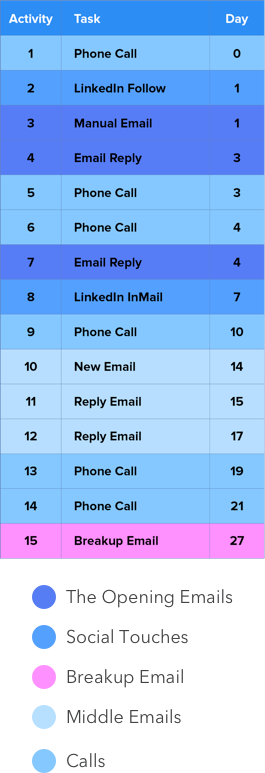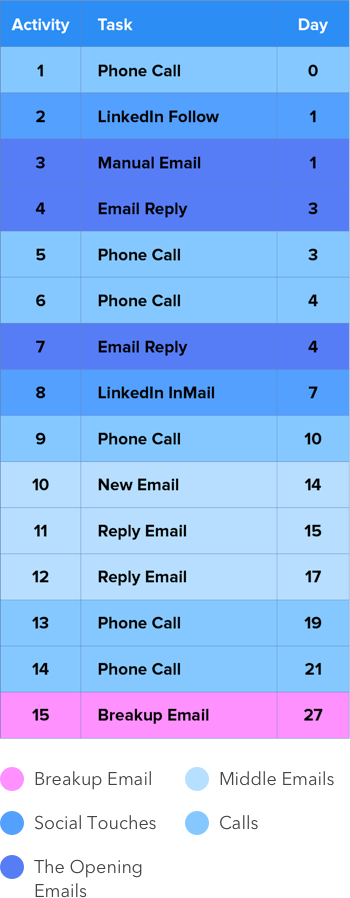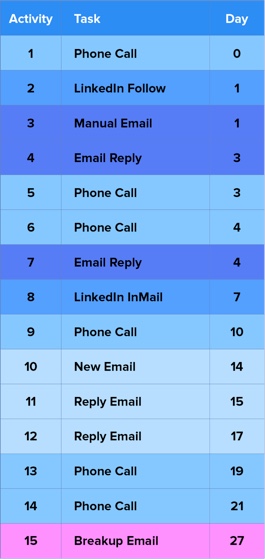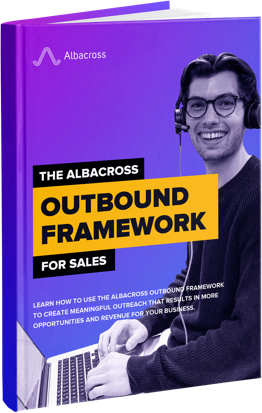We’ve established how intent leads should be distributed and who should be responsible for following up but how should SDRs go about it?
While intent leads are more likely to become qualified since they hit your pre-qualification criteria as per your set up in the Albacross platform, they still need to be nurtured in the same way as any other lead.
Therefore, it’s important to know that leads still need to be qualified and prospected.
The second state of the Outbound Framework is the engage stage. This involves enrolling intent leads into an outbound sequence of phone calls, emails and Linkedin messaging.
Here’s an example of the sequence we use at Albacross.
There are 15 touch points, spanning 27 days. This is based on The Agoge Sequence and it works because it incorporates a combination of outreach tactics which gives you a good foundation to be able to test out which communication channels work for your prospects.
This sequence is just a guideline. If your prospects respond positively on a certain channel, make sure you accommodate that preferred communication channel rather than try to fit them into this sequence.
Once you’ve defined your outbound sequence, you’ll need to consider the following criteria to know who to prioritize within your sequence and what message you should craft:
Making your outbound sequences as relevant as possible will allow you to be more targeted and personalized in your communications.
Firstly, look back to the company-fit model we talked about earlier. Which ICP category does the company fall into?
‘Won’t actively prospect’
company
Next, consider who the contact is by looking at their job role. Which persona do they represent?
Referring to your personas will be important in establishing the level of prioritization you will need to enforce in your prospecting and will ensure you hit all the correct discussion points in relation to their goals and challenges when crafting your messaging.
Create a prioritization matrix like the one below which outlines who your priority personas are.
In the following example, the green tiles are high priority. These are prospects that can become an immediate lead and placed in a call sequence.
The yellow tiles are medium priority. These are prospects that can get you closer to an immediate opportunity. These tiles can be placed into an automated sequence, meaning that if there is a certain level of engagement in a sequence, you can then prospect manually.
Tiles in red are low priority and shouldn’t actively be prospected.

If you have an Albacross integration set up with Hubspot or Salesforce, you can automatically send a number of contacts for a particular account to your CRM. If your priority persona is for example, a Marketing Manager, that means the Marketing Manager’s contact information will appear in your CRM.
If the contact information is not available and you want to prospect a different contact, simply go to the ‘Contact’ tab in the Albacross platform - see below (the link to this part of the platform can also be accessed in the Hubspot or Salesforce record) for that particular account and look up alternative contacts at the company.
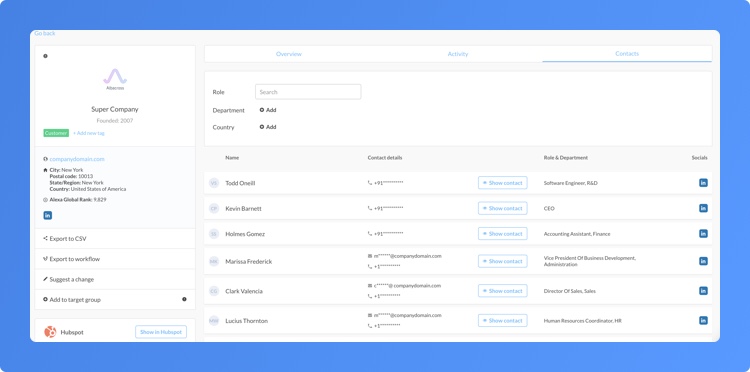
Next, identify the level of intent activity the prospect has made on your website. This will help you create custom messaging and will give an indication of whether you need to amend the sequence stated above.
Typically, we recommend you split intent leads into two categories depending on where they appear to be in the buyer journey.
High buying intent
(These leads should become high priority and should go into an aggressive outbound sequence)
- Visited a product and/or pricing page
- Session duration was above 1 minute
- Number of visits was above 2
Note: You can define high buying intent as just one of these criteria, a combination of or all three. The choice is yours!
Intent leads showing this level of activity should:
- Become top priority for your SDRs
- Should go into an aggressive outbound sequence
- Should be manual and personalized
Low buying intent
- Downloaded content
- Visited blog pages
- Session duration was less than 1 minute
Intent leads that show this level of activity should:
- Become lower priority for your SDRs
- Should go into a nurture sequence
- Should include some level of automation
Once you have identified the level of intent activity these leads show, it’s time to match their activity to their persona. This will help you narrow down the prioritization list even further.
A prioritized prospect list might look like this:
Top priority → Aggressive outbound
- Fits your ICP and priority persona
- Shows high buying intent
Priority → Manual nurture
- Fits your ICP and priority persona
- Shows lowing buying intent
Medium priority → Automated outbound
- Doesn’t fit your ICP or priority persona
- Shows high buying intent
Low priority → Automated nurture
- Doesn’t fit your ICP or priority persona
- Shows low buying intent
Now, let’s get back to our the sequence:
We recommend you use the same sequence of phone calls, emails and LinkedIn messaging for both outbound and nurture sequences (although you can add a few more phone calls to the aggressive outbound sequence if you wish. You could also start the sequence with an email for low priority leads instead of a phone call).
The difference between these sequences will be the level of automation implemented. You can automate all the touches for medium and low priority leads or start by automating just a few. If you choose the latter, we recommend you start by automating the middle emails (those highlighted in green).

Create Meaningful Outreach
Now that we’ve determined how to prioritize intent leads and what type of sequence they should be enrolled into, it’s time to get down to the content.
What should you include in your communications to create meaningful outreach— Outreach that both resonates with your audience and puts SDRs in a position of influence with key decision makers?
Here, we share our best practices for reaching out to Albacross intent leads, messaging examples that work and a checklist you should follow every time your SDRs create an email/video email/LinkedIn inmail or jump on a call.
Best Practices for Email Outreach
The Opening Emails
The first email of a sequence and associated reply emails (we’ll go into these further down) are the most important. A great first email sets the bar for the rest of the sequence.
You should always aim to give the prospect high attention in the first email— the rest of the steps will then be more effective.
For this reason, the first email that you send to a prospect should be personalized.
Consider the following to help you personalize the email:
- Do your research before reaching out to the company.
- What industry are they in?
- Are they hiring people within a certain department that would benefit from your offering?
- Has the prospect written any blog posts/articles recently? Have they been quoted in any recent press releases?
- Create a subject line that is concise and transparent
- The first line of the email should include the reason for reaching out to the prospect. Use Albacross data to determine:
- Firmographic reason, ie. Do they fit your ICP? Industry, number of employees etc
- Demographic, ie. do they work they work within a certain space (to identify persona)
- Psychographic, ie. they have a belief, thought leadership, that relates to your product offering
- Technology, ie. are they using certain technology i.e. a competitor?
- Tie the identified/hypothesized need to your Value Proposition
- Include a CTA (Call to Action)
- For example: “Can you give me a few minutes at 2 pm on Wednesday to discuss this, and, if you don’t think I can help you, then so be it?”
- Keep it short & sweet. Try to keep the email around 4 lines.
Here are some examples of opening emails Albacross’s SDRs recently sent to top priority leads.
Email to top priority lead who visited the pricing page (high buying intent):
→ Day 1 (activity 3 in sequence)
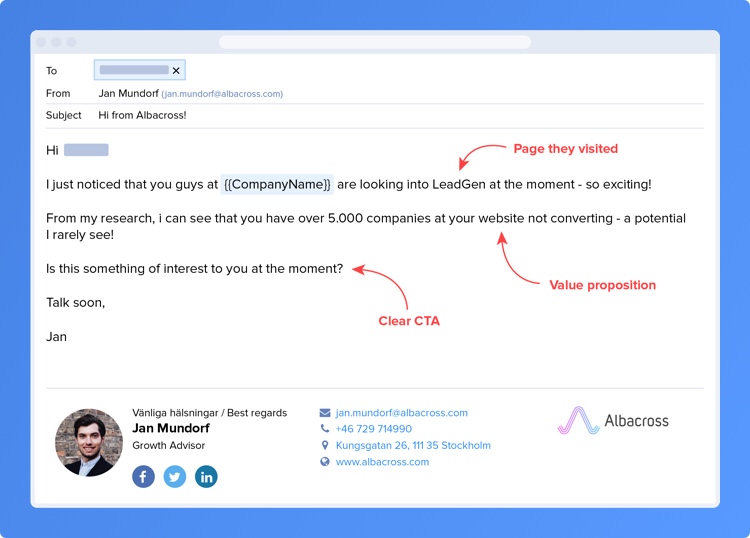
This email keeps it short and sweet. The first sentence uses Albacross data to a) find out who the company was that visited the Albacross website and b) what page they looked at - LeadGen. It then highlights the value proposition and finishes with a clear CTA.
Personalized outbound email to priority lead (low buying intent)
→ Day 1 (activity 3 in the sequence)
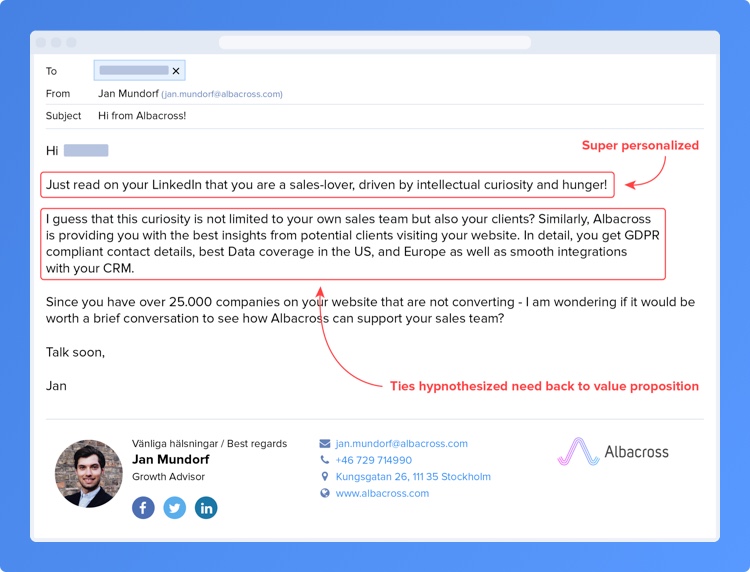
This email does a great job of being super personalized— you can tell Jan has done his research by looking at the prospects LinkedIn profile (profile link available through Albacross).
He’s come up with a hypothesized need the contact may have and tied it back to the value proposition. In addition, he has piqued interest by telling the prospect how many companies are visiting his website but not converting (more detailed value prop), using this to position the call to action.
Personalized nurture email to priority lead (low buying intent)
→ Day 1 (activity 3 in the sequence)
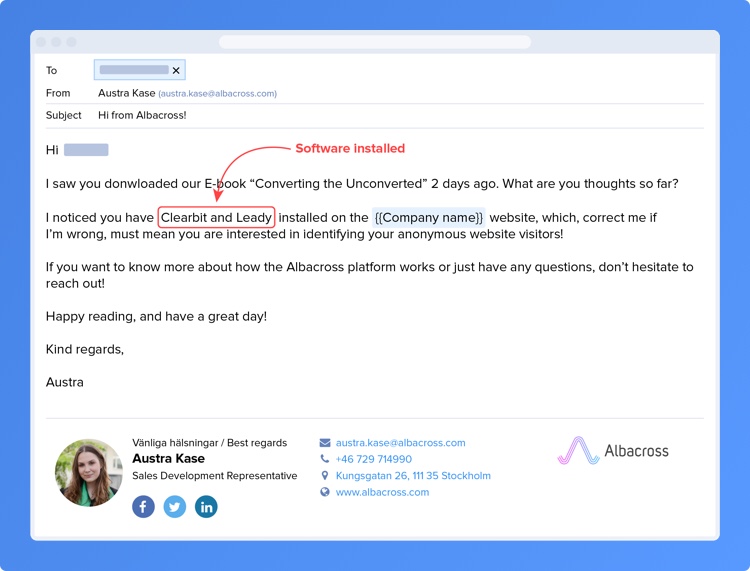
In this email, Austra uses the ebook the prospect recently downloaded to strike a conversation. She also highlights the technologies (which happen to be our competitors) the prospect currently uses (this information is available in the Albacross platform) to increase brand awareness as a leader in the same marketplace.
Reply Emails
The reply emails are a reminder that is sent via the initial email chain (you can send automated reply emails if you wish). This is a follow-up email that you will send to remind the prospect of your initial outreach. The purpose of this email is to serve as a reminder, so keep it short. That way, your original personalized email is still visible.
Here’s an example template:
→ Day 15 (activity 11 in the sequence)
Hi, {{first_name}},
Sorry I missed you on the phone today. I was calling because (leave a one sentence reason for your call, or the name of the referral / event that introduced you).
In my voicemail, I mentioned that I will call you back on [DATE] at [TIME] and of course you can always reach me before then at [YOUR PHONE NUMBER].
I look forward to connecting.
Best,
{{sender_first_name}}
Middle Emails
The middle emails are a set of three emails that can be automated. The first email should be brief and include a clear CTA. The two following emails will be reply emails to remind the prospect if there is no response.
Here’s an example of an email to a low priority lead (automated).
→ Day 14 (activity 10 in the sequence)
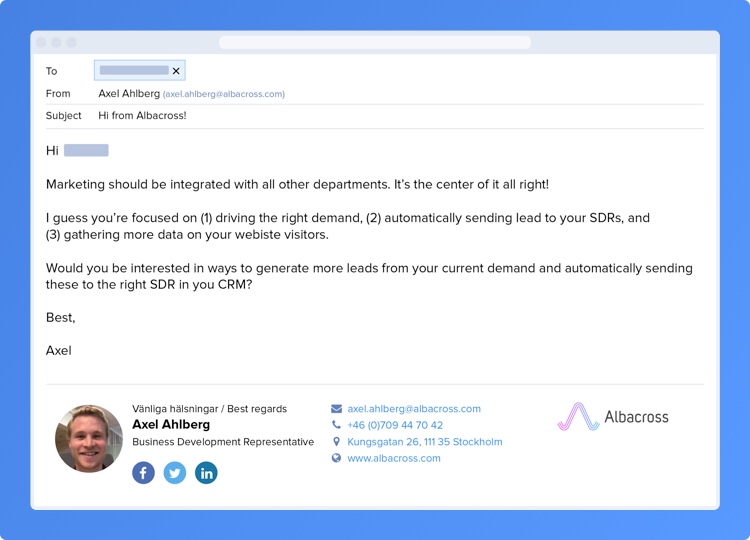
Here’s another example of a middle email:
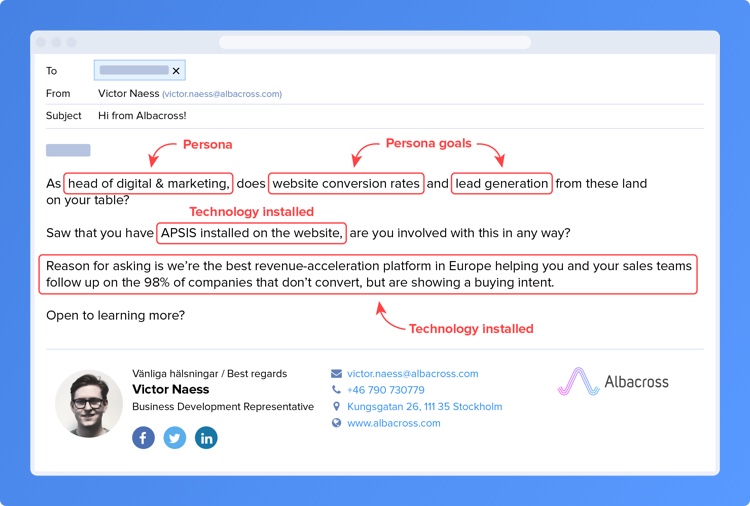
In this email, Victor is trying to confirm the right prospect to talk to at the target company as he’s not received a reply from the initial email. He’s looked at the job role of the prospect and matched that to common goals a Head of Digital and Marketing might have. He’s also identified the technologies installed on the website to ask if the prospect is involved with that software. Finally, he ties that back to the value proposition and concludes with a clear call to action.
It seems to do the trick. Here’s the reply.
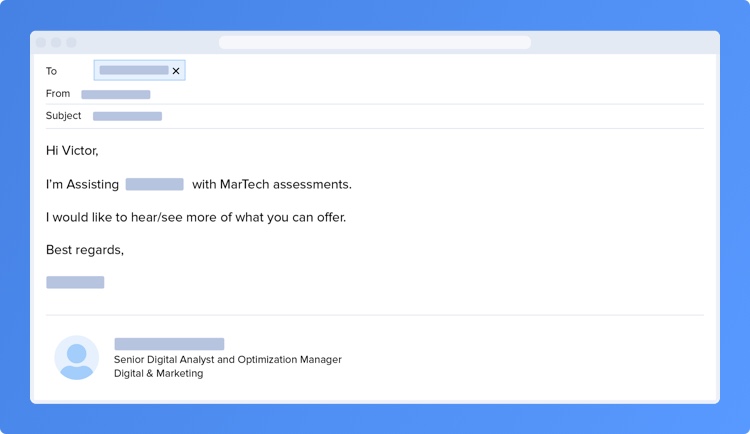
The initial contact has forwarded the email to the relevant person and confirms interest. Victor then books a meeting with the prospect and the rest is history!
If you really want to make your middle emails stand out, you can also add video into the mix.
Here’s one Axel created for a top priority lead identified through Albacross. This is personalization at it’s finest.
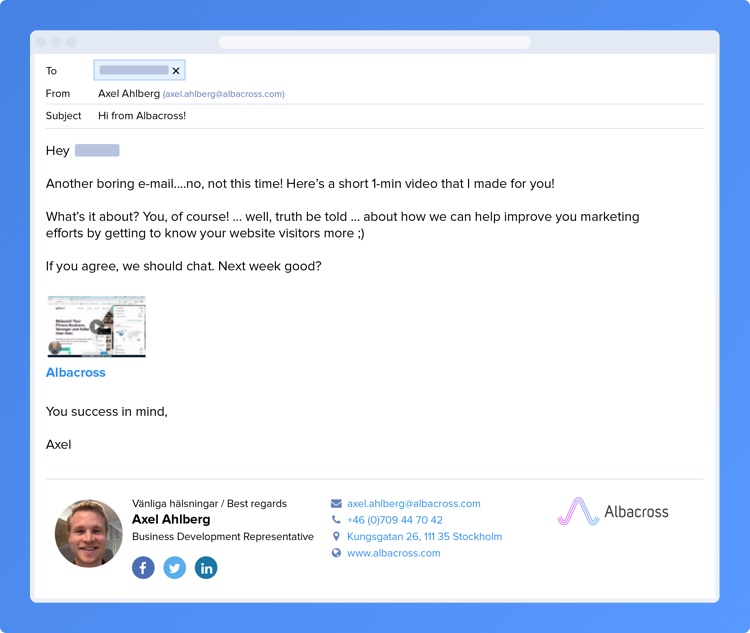
We’ve seen great success with personalized outreach videos, such as Loom videos like this one lately at Albacross. They appear to be working incredibly well during Covid times when the requirements for creativity in how to catch the attention of prospects is accelerated.
Two tips for video:
1. It can’t be a bad message done over video (i.e. why your product is great and why they should take a meeting from you). Instead, it should be focused on a good message known as away messaging (see Skip Miller) that focuses on the pain points or challenges. Pitches that focus on why your product is great is 5-6x less effective than messages that state the pain or the challenges. “I am so sick and tired of….”
2. Remember: Trust and rapport comes from a certain degree of interaction and this is built much faster with video than it is with email. Letting your personality shine through onto the video is just as important as the content you are sharing.
Break up emails
A ‘break up email’ is a little misleading since you’re not actually breaking up however, it is a last attempt at getting in touch with the prospect. A top tip for this email is that it’s better to be remembered than liked. Write an usually direct email to grab the attention of the prospect.
Something like this:
{{first_name}},
I don’t want to be rude but I have been reaching out for weeks and this is starting to feel like a one-way conversation.
I’ve researched you and your company, I’ve called you 6 times, I’ve left messages, InMails...everything in my power. I KNOW {{Company}} can be a game changer for {{Account_Name}}.
Even if you don’t have time for a demo, can we at least chat so you can see why I’m being so persistent?
{{sender_first_name}}
With enough practice, you will be able to convert responses, even negative ones, you receive from these types of emails into meetings surprisingly often.
Here’s a similar email template we use at Albacross.
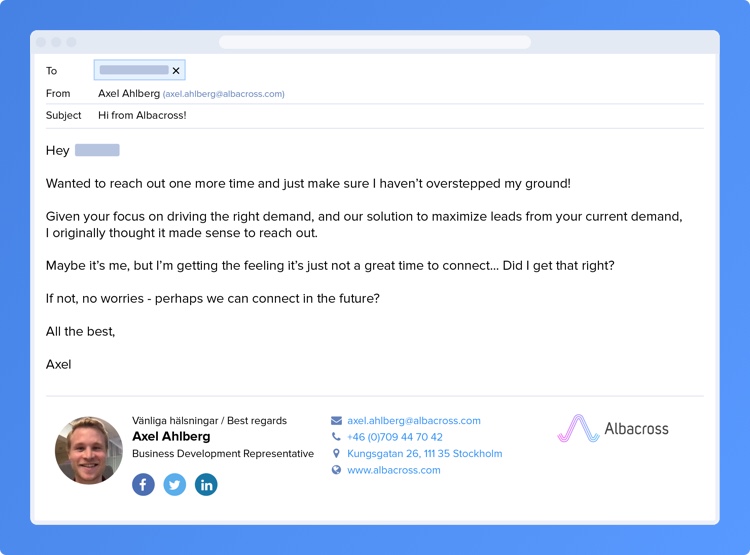
Best Practices for LinkedIn Messaging
After sending the initial email, it’s important to engage with the prospect on LinkedIn. The best way to do this at the start is through a LinkedIn “Connection request” to show interest in their work. Complete this step on Day 1 of the sequence.
On Day 7, if you have not received a correspondence from the prospect, send an InMail to the client that has a similar structure to the opening email.
Here are some templates you can use for LinkedIn Outreach.
Intro message when you request to connect with the prospect:
Hi {{first_name}}, I read an article regarding the recent growth of {{company}}. I’m looking forward to connecting with you to learn more about the {{industry} space.
Follow up with an inmail message:
When creating an InMail for a prospect, reference the “opening email” considerations prior to sending. If you notice that you have mutual connections, find a commonality that may build rapport.
Best Practices for Phone Calls
When you call someone at the target account who visited your website you have a chance to have a real, authentic human interaction. This enables you to build trust and establish a connection with them. If you don’t reach the decision maker straight away over the phone, make sure to express that people at their company have been looking at your site and you need pointing in the right direction.
If you don’t find the person that visited your site, don’t despair! Keep trying - people are nice. Someone will always be willing to help you.
Here’s the script our SDRs use at Albacross.
Gatekeeper
Ask to be connected to the person that you want to talk to:
Hey, Viktor here from Albacross, do you have Peter Jonsson in today? Can you direct me please.
Be creative! If you receive an objection, find an alternative way to get through - use the data in the Albacross platform, and the research you conducted to create rapport with the gatekeeper.
The Decision Maker (DM)

- Either you get an introduction to someone else
- Or, this guy tells you he is the right person
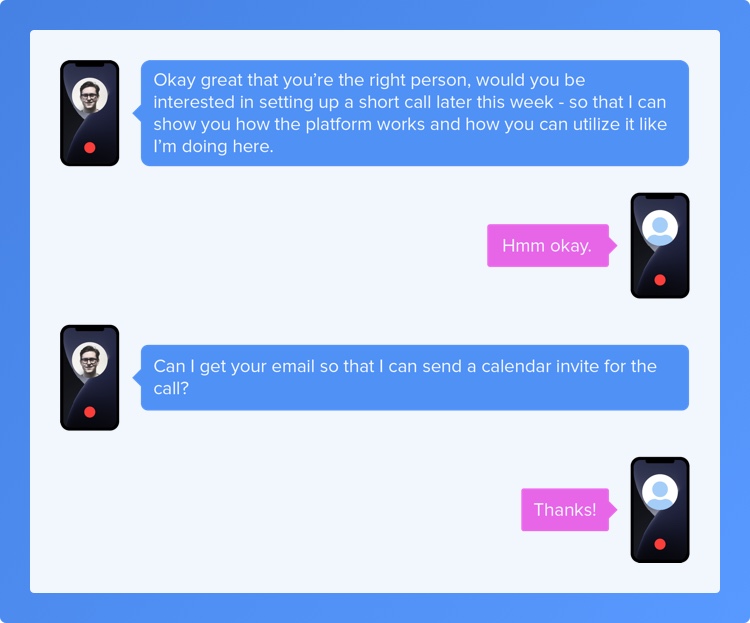
Actions to take after the call:
- Send a calendar invite
- Move them to a booked meeting in your outbound pipe
- Do more research prior to the next meeting
The above examples of outreach for intent leads are just that, examples. You can use them as a reference point when crafting your own communications. You’ll need to adapt your messaging for your business and your prospects. But one thing is for sure, there’s always best practices to follow with EVERY interaction you make.
Checklist for Meaningful Outreach. Everytime.
Here at Albacross our SDRs use the following ‘BE’ checklist to ensure we’re always creating meaningful outreach.
1. BE Customer-focused.
Every salesperson needs to take themselves out of the picture when writing the initial email. This email needs to be centered around the prospect. As a sales leader, encourage your sales team to be diligent and creative when researching their prospecting.
2. BE Relevant.
Frame your message to show how your product/service can help your prospect overcome their objective challenges. To make sure your SDRs are relevant, discuss personas regularly and conduct workshops to provide landscape knowledge.
3. BE Meaningful.
Nobody likes a cold email. Differentiate yourself from the competition by creating content with an objective to build rapport and make a great impression. To do that, you really need to know who you’re talking to and make your outreach meaningful.
4. BE Concise.
Make sure your email content is concise and flows from the premise > body > CTA. Too many value propositions can be confusing and take away from the key message. Keep it simple & meaningful.
5. BE Bold.
The subject line is Golden. If you can’t pique the reader’s interest within the subject line, all of your hard work to create strong meaningful content is wasted. Be bold, concise and creative.

